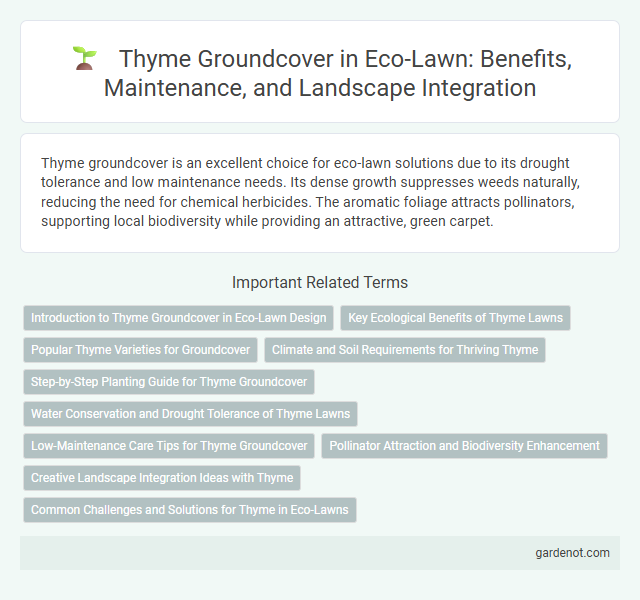Thyme groundcover is an excellent choice for eco-lawn solutions due to its drought tolerance and low maintenance needs. Its dense growth suppresses weeds naturally, reducing the need for chemical herbicides. The aromatic foliage attracts pollinators, supporting local biodiversity while providing an attractive, green carpet.
Introduction to Thyme Groundcover in Eco-Lawn Design
Thyme groundcover is an ideal choice for eco-lawn design due to its drought resistance, low maintenance, and ability to improve soil health by fixing nitrogen. Its dense growth habit suppresses weeds while providing a fragrant, resilient green cover that thrives in well-drained soils and full sun. Incorporating thyme in eco-lawns enhances biodiversity and supports pollinators, making it a sustainable alternative to traditional grass lawns.
Key Ecological Benefits of Thyme Lawns
Thyme groundcover in eco-lawns enhances biodiversity by providing nectar-rich flowers that support pollinators like bees and butterflies. Its drought tolerance and low water needs reduce irrigation demands, promoting sustainable water use. Thyme's natural resistance to pests minimizes chemical inputs, fostering healthier soil ecosystems.
Popular Thyme Varieties for Groundcover
Popular thyme varieties for groundcover include Creeping Thyme (Thymus serpyllum), known for its dense, low-growing habit and aromatic foliage that attracts pollinators. Woolly Thyme (Thymus pseudolanuginosus) offers soft, silver-green leaves ideal for filling spaces between stones and paths. Silver Carpet Thyme (Thymus callitrichus) features bright, silvery foliage and vibrant pink flowers, providing both aesthetic appeal and hardy ground coverage.
Climate and Soil Requirements for Thriving Thyme
Thyme groundcover thrives in well-drained, sandy or rocky soils with a pH range of 6.0 to 8.0, making it ideal for eco-lawns in Mediterranean and temperate climates. This drought-tolerant herb requires full sun exposure and performs best in areas with minimal humidity and moderate rainfall. Proper soil aeration and avoiding waterlogged conditions are crucial for sustaining healthy thyme growth.
Step-by-Step Planting Guide for Thyme Groundcover
Thyme groundcover thrives in well-drained soil with full sun exposure, making site preparation crucial for successful planting. Begin by loosening the soil to a depth of 6-8 inches and incorporating organic compost to enhance nutrient content. Space thyme plants 12-18 inches apart, water thoroughly after planting, and maintain consistent moisture until established to promote vigorous growth and dense coverage.
Water Conservation and Drought Tolerance of Thyme Lawns
Thyme groundcover offers exceptional water conservation benefits by thriving in low-moisture environments, reducing the need for frequent irrigation. Its deep-root system enhances drought tolerance, maintaining lush coverage even during prolonged dry spells. This resilience makes thyme lawns an eco-friendly, sustainable alternative to traditional grass lawns in arid and semi-arid regions.
Low-Maintenance Care Tips for Thyme Groundcover
Thyme groundcover thrives in well-drained soil with full sun exposure, requiring minimal watering once established, which makes it an ideal choice for eco-friendly lawns. Regular pruning after flowering promotes healthy growth and prevents the plant from becoming woody, enhancing its durability and appearance. Avoid heavy fertilization; a light application of organic compost in early spring supports its natural resilience and low-maintenance appeal.
Pollinator Attraction and Biodiversity Enhancement
Thyme groundcover is highly effective in attracting pollinators such as bees and butterflies, contributing significantly to local biodiversity. Its dense, low-growing foliage provides habitat and nectar sources that support a variety of beneficial insects, enhancing ecosystem health. Incorporating thyme into eco-lawns promotes sustainable pollination while enriching soil quality and increasing habitat complexity.
Creative Landscape Integration Ideas with Thyme
Thyme groundcover enhances eco-lawns by offering drought-resistant, low-maintenance greenery that thrives in sunny, well-drained soil. Creative landscape integration ideas include planting thyme between stepping stones to create fragrant pathways, using it as a natural lawn alternative for foot traffic areas, and combining it with native wildflowers to boost biodiversity and attract pollinators. Its ability to suppress weeds while releasing pleasant herbal scents makes thyme an ideal choice for sustainable and visually appealing garden designs.
Common Challenges and Solutions for Thyme in Eco-Lawns
Thyme groundcover in eco-lawns often faces challenges such as dry soil conditions, limited nutrient availability, and susceptibility to foot traffic damage. Solutions include improving soil drainage, applying organic compost to enhance nutrient levels, and choosing drought-tolerant thyme varieties that withstand occasional trampling. Regularly monitoring soil moisture and avoiding overwatering helps maintain plant health and resilience in sustainable lawn ecosystems.
Thyme groundcover Infographic

 gardenot.com
gardenot.com